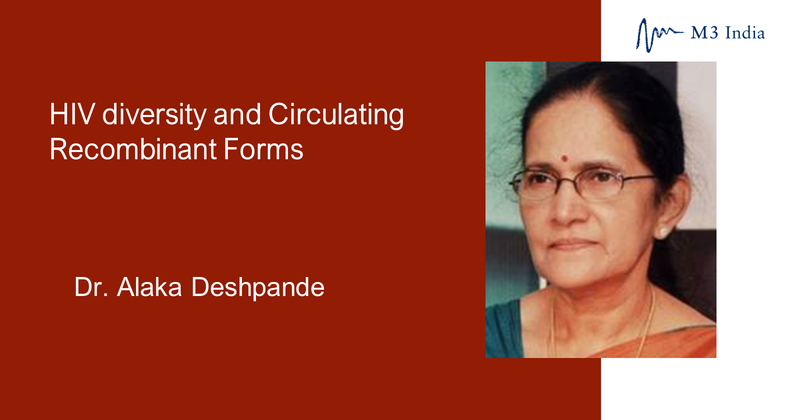HIV diversity and Circulating Recombinant Forms- Dr. Alaka Deshpande
M3 India Newsdesk Jan 03, 2019
Prof. Dr. Alaka Deshpande, a Padmashree awardee and a WHO-recognised expert in dealing with HIV/AIDS shares quick notes on HIV diversity and circulating recombinant forms (CRFs).

Prof. Dr. Deshpande was awarded Padma Shri in 2001 for her path-breaking contribution in the area of HIV care. She has been a Technical Expert on the World Health Organisations Strategic and Technical Advisory Committee on HIV/AIDS, contributing her expertise in this disease from the Indian perspective. The HIV/AIDS awareness campaign was conducted under her guidance.
With advances in molecular technology, the structure of the HIV virus has been studied in more detail to find out newer drug targets and also to explore the possibility of a vaccine. It is, therefore, necessary to review the HIV diversity.
HIV Diversity
Two types of HIV have been identified viz. HIV 1 and HIV 2. HIV 1 is further subdivided into 4 subgroups. Subgroup M is the major group which has 8 subtypes. The distribution of various groups is given below:
- M—Worldwide distribution 35 M infected
- All subtypes Subsaharan Africa
- B--- North n South America, Western Europe ( 10 % )
- A --- Eastern Europe ( 12 % )
- C---- India, Southern Africa ( 50 % )
- D 3 %
- G 6 %
- A/E CRFO1, FO2 5 % each Southeast Asia
- O—0.1 -1 % Cameroon
- N and P virus - 20 and 3 people respectively are found to be infected in Cameroon.
Further, there are sub-subtypes like A 1, A2, A3 and F1, F2. The implications are related to their drug sensitivity as well as vaccine development.
HIV 2 characteristically progresses slowly. The subtypes are:
- A and B are most prevalent
- Less pathogenic, Slower progression to AIDS
- PPTCT** 2 % to 7 %
- West Africa, India
- Innate Resistance to NNRTI***
- Recombinant of HIV 1+ HIV 2 are not found in man
Anna Maria Geretti in her article states “Genetic differences amongst HIV -1 variants can influence the virus biological properties, susceptibility to the existing and candidate ARVs, and evolution of antiretroviral resistance. Further studies are required to define its impact on risk of transmission, disease outcome, response to ARVs and resistance pathways.”
- Currently, we are using the data of subtype B for non-B subtypes for therapy as well as resistance.
- Subtype C has poor entry efficiency but it is predominant in the epidemic. It has a greater propensity for in-utero transmission and has higher levels of shedding in the genital tract.
- Subtype C and D are more aggressive followed by G, AE and AG, while A is the least aggressive.
- In addition, many Circulating Recombinant forms are being detected.
What are CRFs --Circulating Recombinant Forms?
Survival of the fittest is the rule.
- A frequent action of a retrovirus to enlarge its genetic repertoire is by the formation of recombination
- When a cell gets infected by two genetically different HIV viruses, the RT may use both RNA templates for the DNA synthesis
- An increasing number of different subtypes are in co-circulation, and as a result, CRFs are increasing
- Recombination of different members of quasispecies is frequent
- It is known that RT is error-prone, there is no proofreading mechanism
- 1 error occurs/10000 nucleotides produced, that is, every new virus produced is different from the parent quasispecies
- Recombinant event in one cell occurs 1 in 400 HIV particles produced
- Recombination of quasispecies, and also super-infections by other subtypes probably result in CRFs
- When transmission of the recombinant virus is documented in more than 3 epidemiologically different individuals it is known as CRF and if it is detected in less than 3 individuals it is known as Unique recombinant form
- When recombination is between less than 3 viruses, it is denoted by a number e.g. CRF 01AE, CRF02AG
- When recombination is between 3 or more different strains it is given the extension of cpx, e.g. CRF 18_cpx
- Until now, 98 CRFs have been identified
- The strain that acquires the highest adaptive capacity in a given environment will survive and predominate
What is the significance of CRFs?
It helps to understand the origin, evolution, migration of virus, spread and pathogenesis. But, it is quite challenging to study the epidemiology and evolution of CRFs.
The clinical implications need to be studied. What are the replicative rates of each CRF, its infectivity, the rapidity with which it causes CD4 decline. The clinical spectrum may differ depending on its virulence. The drug susceptibility and resistance pattern may differ. Lastly, it is a challenge for vaccine development. We cannot afford to be complacent as a new epidemic with a drug-resistant virus and an epidemic of CRFs may be seen in the near future!
**PPCT=Prevention of Parent-to-Child-Transmission
***NNRTI= Non-nucleoside reverse-transcriptase inhibitors
Disclaimer- The views and opinions expressed in this article are those of the author's and do not necessarily reflect the official policy or position of M3 India.
-
Exclusive Write-ups & Webinars by KOLs
-
Daily Quiz by specialty
-
Paid Market Research Surveys
-
Case discussions, News & Journals' summaries